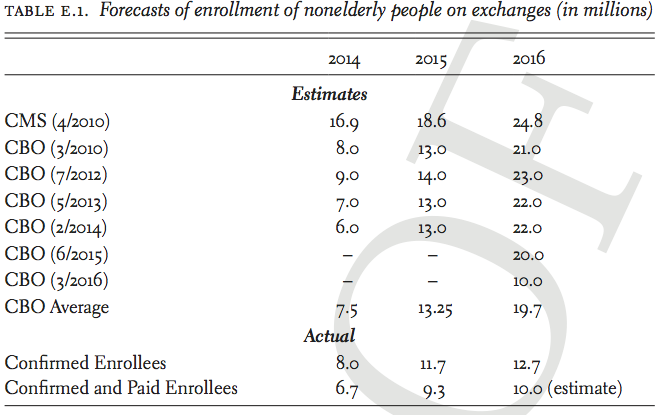[Josh Blackman] How the Obama administration’s executive actions sabotaged Obamacare
The Volokh Conspiracy 2016-09-26
Summary:
After six years of pitched political battle, it has become conventional wisdom that Republicans are responsible for the Affordable Care Act’s unraveling. In part, this is true. Specifically, the refusal of red states to enter the Medicaid expansion and the defunding of the “risk corridors” have limited the law’s success.
However, many of Obamacare’s deepest wounds have been self-inflicted. Out of desperation to ensure as many people as possible signed up for health insurance, the Obama administration has arbitrarily suspended onerous mandates, modified coverage requirements and extended enrollment periods. These illegal, ad hoc changes to the ACA — which I’ve referred to as “government by blog post” — have unintentionally, but foreseeably, weakened the exchanges during the pivotal first three years.
The leading measure of the ACA’s success is the number of people who have enrolled on the exchanges. This table, from the epilogue of “Unraveled,” illustrates how the law has fallen far short of its great expectations.

In 2014, Obamacare met the Congressional Budget Office’s original goal from 2010, with 8 million enrollments. This was truly a red-letter year for the ACA, demonstrating that there was strong demand for the exchange policies. After 2014, however, the demand has leveled off. In 2015, there were 11.7 million enrollments, far fewer than the CBO’s average forecast of 13.25 million. From 2010 through 2015, the CBO consistently predicted that enrollments would spike up in 2016, with 20 million to 24 million enrollments.
For example, in its February 2014 report, the CBO wrote that “more people are expected to respond to the new coverage options, so enrollment is projected to increase sharply in 2015 and 2016.” The surge never happened. In March 2016, the CBO drastically downgraded its forecast by half to 10 million enrollees. As of July 2016, there have been 12.7 million confirmed enrollees on the exchange — beating the revised 10 million figure, but falling significantly short of the expected 20 million. The ACA’s expansion of coverage to 20 million Americans is still far short of even its most conservative estimate of more than 30 million Americans gaining coverage.
Another measure of the ACA’s success is quantifying how many people have paid the individual mandate penalty. That is, qualified individuals who do not carry “minimum essential coverage” are obligated to pay an income-adjusted-penalty. The purpose of the penalty, as the government explained to the Supreme Court in NFIB v. Sebelius, was to prevent people from free-riding on the provision of the law that guarantees issuance of policies to everyone, regardless of pre-existing conditions.
Like the exchange enrollment numbers, the collected penalty revenue has lagged far behind original estimates.

There is an incongruence to these forecasts. The number of people who have gained coverage on the ACA exchange is far fewer than originally forecast: 10 million instead of 20 million. As a result, more people who otherwise would have obtained coverage should now be subject to the mandate’s penalty. The revenue should be far greater than originally predicted. But the exact opposite happened.
This shortfall can be explained by two executive actions taken by the Obama administration, which allowed people to avoid purchasing qualified insurance, without having to pay the individual mandate’s penalty.
The Administrative Fix
The first such executive action is known as the “administrative fix.” President Obama promised nearly three dozen times that “if you like your plan, you can keep your plan.” Of course, this was a promise that could never be kept. Due to strict grandfathering regulations promulgated by the Obama administration, insurers canceled policies that did not provide “essential coverage.”
During the fall of 2013, as millions of Americans received cancellation notices, the president’s oft-stated promise crumbled. In response, in November 2013 he announced an executive action that came to be know as the “administrative fix.” To grossly oversimplify, the federal government would not enforce the individual mandate’s penalty against individuals who continued to carry these policies that would otherwise be void. The policy gave states, and ultimately the insurers, the choice of whether to continue selling these policies. I’ve argued elsewhere that this fix was unlawful, but most relevant for our purposes is how it impacted the vitality of the exchanges.
There were risks to allowing people to remain on old plans. Jim Donelon, former president of the National Association of In